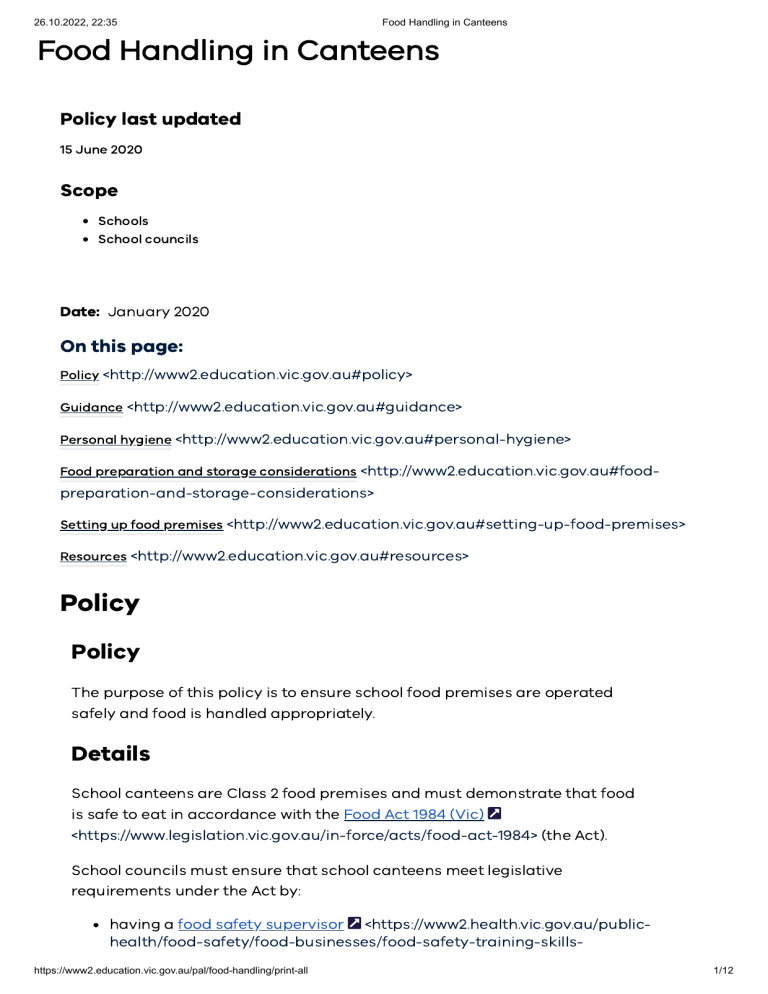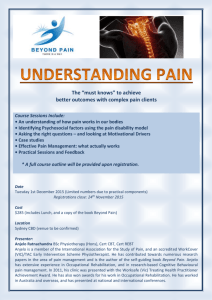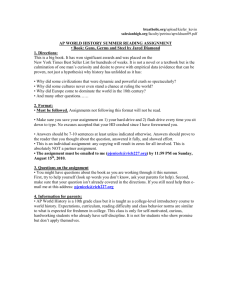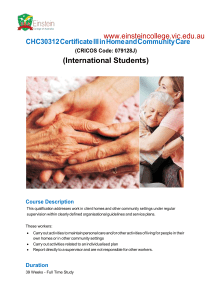
26.10.2022, 22:35 Food Handling in Canteens Food Handling in Canteens Policy last updated 15 June 2020 Scope Schools School councils Date: January 2020 On this page: Policy <http://www2.education.vic.gov.au#policy> Guidance <http://www2.education.vic.gov.au#guidance> Personal hygiene <http://www2.education.vic.gov.au#personal-hygiene> Food preparation and storage considerations <http://www2.education.vic.gov.au#food- preparation-and-storage-considerations> Setting up food premises <http://www2.education.vic.gov.au#setting-up-food-premises> Resources <http://www2.education.vic.gov.au#resources> Policy Policy The purpose of this policy is to ensure school food premises are operated safely and food is handled appropriately. Details School canteens are Class 2 food premises and must demonstrate that food is safe to eat in accordance with the Food Act 1984 (Vic) <https://www.legislation.vic.gov.au/in-force/acts/food-act-1984> (the Act). School councils must ensure that school canteens meet legislative requirements under the Act by: having a food safety supervisor <https://www2.health.vic.gov.au/publichealth/food-safety/food-businesses/food-safety-training-skillshttps://www2.education.vic.gov.au/pal/food-handling/print-all 1/12 26.10.2022, 22:35 Food Handling in Canteens knowledge/food-safety-supervisors> with the training, skills and knowledge to ensure that: all regulations are followed anyone handling food has the correct training ensuring a food safety program <https://www2.health.vic.gov.au/publichealth/food-safety/food-businesses/food-safety-program/food-safety-program-class-2> is prepared based on the Department of Health and Human Services template. Information on where schools can purchase this template can be found in the Resources section lodging the food safety program with the municipal council at the time of registration and re-registration Information on the recommended practices that will assist schools in complying with food safety and food handling regulations can be found in the Guidance <http://www2.education.vic.gov.au/pal/food-handling/guidance> tab. Definitions Class 2 premises Class 2 food premises are those whose main activity is handling unpackaged potentially hazardous foods which need correct temperature control during the food handling process, including cooking and storage, to keep them safe. This includes restaurants, fast food outlets, pubs, caterers, delicatessens, supermarkets with delicatessens, cafes and most manufacturers. For more information on the classification of food premises, refer to food business classification <https://www2.health.vic.gov.au/public-health/foodsafety/food-businesses/food-business-classification/food-business-classification-tool> on the Department of Health and Human Services website. Related policies Canteens <http://www2.education.vic.gov.au/pal/canteens/policy> Relevant legislation Food Act 1984 (Vic) <https://www.legislation.vic.gov.au/in-force/acts/foodact-1984> https://www2.education.vic.gov.au/pal/food-handling/print-all 2/12 26.10.2022, 22:35 Food Handling in Canteens Guidance Safe Food Handling Guidance This guidance summarises recommended practices that will assist schools in complying with food safety and food handling regulations. It contains the following chapters: Personal hygiene Food preparations and storage considerations Setting up food premises https://www2.education.vic.gov.au/pal/food-handling/print-all 3/12 26.10.2022, 22:35 Food Handling in Canteens Personal hygiene Personal hygiene Good personal hygiene is essential to ensure that: food is not contaminated with food-poisoning bacteria or other matter, such as: foreign objects chemicals hands and other parts of the body do not transfer food-poisoning bacteria to food Personal hygiene practices include: hand washing — always wash hands thoroughly with soap and warm water: before handling food after any other activity that may carry bacteria to food visiting the toilet coughing or sneezing handling garbage touching hair or other body parts personal cleanliness — when handling food: tie long hair back or cover it with a cap or other approved headwear wear limited jewellery wear clean protective clothing over normal clothing store personal items and spare clothes away from any areas involving food handling personal behaviour and habits — do not: smoke chew gum undertake any other unhygienic practice in food handling areas illness — individuals suffering from diseases that can be transmitted through food must not handle food injuries — all wounds or cuts on hands or arms are to be completely covered with brightly coloured wound strip or bandage: both the wound strip and gloves must be changed at least hourly or sooner if there is a change in tasks https://www2.education.vic.gov.au/pal/food-handling/print-all 4/12 26.10.2022, 22:35 Food Handling in Canteens if the wound is on the hands, disposable gloves must be worn over the top of the wound strip For more information visit Food — how to keep it safe <https://www2.health.vic.gov.au/public-health/food-safety/foodbusinesses/food-how-to-keep-it-safe > at health.vic https://www2.education.vic.gov.au/pal/food-handling/print-all 5/12 26.10.2022, 22:35 Food Handling in Canteens Food preparation and storage considerations Food preparation and storage considerations Food naturally contains bacteria and some food may contain food poisoning bacteria. Foods need to be handled correctly to ensure that: they do not become contaminated that bacteria already in the food do not have an opportunity to grow It is important to keep raw food totally separate from cooked or ready-to-eat foods. If raw food is cooked thoroughly most of these bacteria will be killed However, if raw food comes into contact with other food that has already been cooked, or is ready-to-eat, the bacteria can transfer to this food. This is called cross-contamination. The below information outlines key food preparation and storage considerations. Receiving food Perishable foods supplied must be transported in a refrigerated food vehicle or refrigerated containers. The temperature of deliveries should be checked. Food that needs refrigeration must be transported at below 5°C. Dry goods being delivered need to be checked for unbroken packaging, such as: bread cans Preparing food Use separate utensils, chopping boards and other equipment for raw and ready-to-eat foods to avoid cross-contamination. If this is not possible, thoroughly wash and sanitise equipment between use. Thoroughly wash all fruit and vegetables before use. Don't use any food if you cannot guarantee its freshness. Handling food https://www2.education.vic.gov.au/pal/food-handling/print-all 6/12 26.10.2022, 22:35 Food Handling in Canteens Raw foods, which are to be cooked, can be safely handled with bare hands (provided hands are clean). Cooked or ready-to-eat foods should be handled with utensils such as: tongs spoons spatulas disposable gloves. Important — if gloves are worn: they must be changed at least hourly or sooner if they become torn if there is a change in task for example when changing from raw to ready-to-eat food always wash hands before putting on gloves never touch food with gloves that have been used for cleaning Cooking and heating food Thaw food in the bottom part of the refrigerator before cooking. Microwave ovens can be used to thaw food provided that the food is cooked immediately afterwards. Never refreeze food that has been thawed. All food is thoroughly cooked, especially those of animal origin and ensure the juices run clear. If food can be cooked from a frozen state extra care must be taken to ensure the food is cooked right through. If reheating food ensure that it is brought to the boil and simmered for at least five minutes. Storage and display If food is not stored, displayed or transported correctly the naturally forming bacteria can multiply to dangerous levels. One of the most important factors for growth is temperature with the known danger zone being between 5° and 60°. High risk foods such as meat, dairy products and seafood must spend only the minimum possible time in this zone. These same foods produced in the form of dried food powders in their original packaging, jars, cans and other containers of which have been processed by heat are not categorised as high risk foods. Safety can be maintained by correctly storing food: https://www2.education.vic.gov.au/pal/food-handling/print-all 7/12 26.10.2022, 22:35 Food Handling in Canteens controlling the temperature of high risk foods: keep cold food below 5°C keep hot food above 60°C checking equipment, particularly the operating temperatures of refrigerators and freezers including: buying a thermometer and monitor temperatures immediately reporting malfunctioning equipment to the principal (or campsite owner if at a camp) keeping frozen food frozen defrosting freezers regularly and not overloading them covering food with lids, foil or plastic film ensuring food does not remain in storage too long once a can is opened, any remaining food should be transferred to a suitable container and labelled with the date do not store in the can storing chemicals, cleaning equipment and personal belongings away from food preparation and food storage areas food that is displayed must either be wrapped or covered bain-maries (or hot holding devices) are to keep hot foods above 60°C. They are not to be used to: reheat foods stack food above the tray level or else it will not remain sufficiently hot For more information visit Food — how to keep food safe <https://www2.health.vic.gov.au/public-health/food-safety/foodbusinesses/food-how-to-keep-it-safe> at health.vic https://www2.education.vic.gov.au/pal/food-handling/print-all 8/12 26.10.2022, 22:35 Food Handling in Canteens Setting up food premises Setting up food premises Permanent food premises need to be: registered with the municipal council built and designed so that the food can be prepared safely and efficiently Contact your local council environmental health officer for details on building requirements for permanent food-handling premises and facilities. Temporary food premises such as food stalls for a fete, barbecues, sausage sizzles need to: be constructed so that they can prevent the contamination of food, particularly by dust, insects and customers ensure all benches and tables have surfaces that are smooth and able to be cleaned have facilities for hand washing and utensil washing facilities. If a sink connected to a water supply is not available near the stall, temporary facilities will need to be provided utensil washing facilities must be made available, including: sealed container or drum with clean water water-heating device, such as an urn, so that hot water is available bucket to collect dirty water detergent and disposable paper towels. utensils should be washed as soon as possible in clean, soapy water and rinsed in clean water. All waste water must be disposed to the sewer, not storm-water have adequate refrigeration and rubbish receptacle Note: Contact the local council environmental health officer to discuss any additional requirements such as completion of an application for stalls held off campus. For more information visit: Food businesses <https://www2.health.vic.gov.au/public-health/foodsafety/food-businesses> at health.vic Information for community groups selling food to raise funds <https://www2.health.vic.gov.au/public-health/food-safety/food-safety-information-for-community-groups> at health.vic https://www2.education.vic.gov.au/pal/food-handling/print-all 9/12 26.10.2022, 22:35 https://www2.education.vic.gov.au/pal/food-handling/print-all Food Handling in Canteens 10/12 26.10.2022, 22:35 Food Handling in Canteens Resources Resources Templates Food safety program template <https://www2.health.vic.gov.au/publichealth/food-safety/food-businesses/food-safety-program/food-safety-program-templates/food-safety-program-template-class-2> — the Department of Heath and Human Services has developed an easy-to-use, simplified food safety program template for class 2 premises Useful websites FoodSmart <https://www.foodsmart.vic.gov.au/> — a standard food safety program, registered by Department of Health and Human Services Food Safety Standards <https://www.foodstandards.gov.au/consumer/safety/faqsafety/pages/foodsa fetyfactsheets/foodpremisesandequip71.aspx> — contains the standards that regulate the use of ingredients, processing aids, colourings, additives, vitamins and minerals Home Economics Victoria <https://www.homeeconomics.com.au/> — contains professional development opportunities for teachers, curriculum support and other resources DoFoodSafely <http://dofoodsafely.health.vic.gov.au/index.php/en/> — a free, non-accredited, online learning program provided by the Department of Health and Human Services Victoria and supported by Queensland Health and South Australia Health https://www2.education.vic.gov.au/pal/food-handling/print-all 11/12 26.10.2022, 22:35 Food Handling in Canteens Reviewed 28 February 2020 https://www2.education.vic.gov.au/pal/food-handling/print-all 12/12





